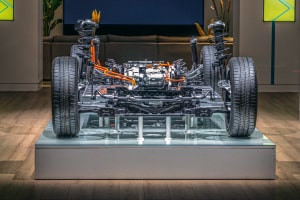We see more and more electric vehicles on our roads every day as they are four times more energy-efficient than combustion engine vehicles, which makes them more accessible and reliable, and they do not pollute the environment with CO2 emissions. The course opens by explaining how the flow of energy works by unpacking Ohm’s law to help you understand how electric energy travels through a circuit. You then encounter Kirchhoff's first two laws to understand both mass and energy conservation. These rules establish the flow of thermal and magnetic energies and their role in converting electrical energy into mechanical energy. This also covers the function of magnetic flux inside an electric motor.
This brings us to torque production inside an electric motor and commutation’s role in creating it. We explore a PMDC motor involving split rings and sliding carbon brushes for commutation to discover how it produces torque. We then investigate a permanent magnet synchronous motor (PMSM), which has higher torque, a smaller frame and no rotor current, making it the motor of choice for electric vehicles. As you navigate the PMSM, you will become familiar with three-phase circuits, the synchronous d-q frame theory and ‘Park and Clarke transform’. This course teaches you the crucial methods involved in designing a field-oriented control and how to control the amplitude, phase and frequency of the voltage the battery provides to operate the motor.
We show you how to build a thermal profile for the motor using Norton's Theorem to demonstrate how heat flows and how you can improve resistances along the way. This thermal profile will help you judge whether or not the peak temperatures produced by your design will be within acceptable limits. This brings us to chargers as you see how chargers are designed and function. Special attention is given to public chargers, their design, the standards that govern them in different countries and how they communicate with the power grid and local energy operator. In some countries, the concept of ‘battery swapping’ is being legalized, which can make purchasing and operating an electric vehicle more accessible to drivers. We wrap up with an explanation of vehicle analytics and their role in guaranteeing the vehicle’s safety and ensuring the development of improved future models. This course is for anyone who is passionate about vehicle technology and wants to help the environment by gaining new engineering skills that will advance their career.
What You Will Learn In This Free Course
View All Learning Outcomes View Less All Alison courses are free to enrol, study, and complete. To successfully complete this Diploma course and become an Alison Graduate, you need to achieve 80% or higher in each course assessment.
Once you have completed this Diploma course, you have the option to acquire an official Diploma, which is a great way to share your achievement with the world.
Your Alison certificate is:
- Ideal for sharing with potential employers.
- Great for your CV, professional social media profiles, and job applications.
- An indication of your commitment to continuously learn, upskill, and achieve high results.
- An incentive for you to continue empowering yourself through lifelong learning.
Alison offers 2 types of Diploma for completed Diploma courses:
- Digital Diploma: a downloadable Diploma in PDF format immediately available to you when you complete your purchase.
- Physical Diploma: a physical version of your officially branded and security-marked Diploma
All Diplomas are available to purchase through the Alison Shop. For more information on purchasing Alison Diploma, please visit our FAQs. If you decide not to purchase your Alison Diploma, you can still demonstrate your achievement by sharing your Learner Record or Learner Achievement Verification, both of which are accessible from your Account Settings.











 Avg. Hours
Avg. Hours  Contains Video
Contains Video  CPD Accredited
CPD Accredited 
 Total XP:
Total XP: 
 Knowledge & Skills You Will Learn
Knowledge & Skills You Will Learn 






